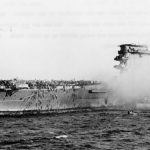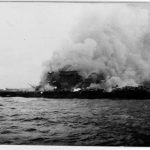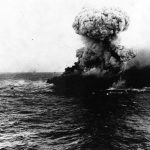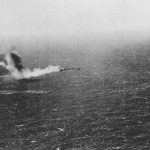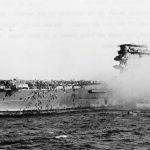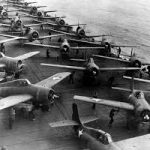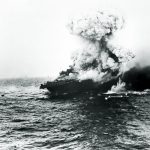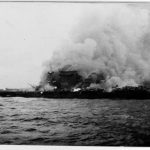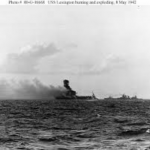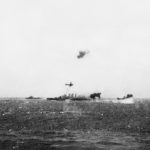WWII battle sets stage for Japan’s defeat
 It’s been 76 years since the World War II battle that set the stage for Japan’s defeat — and changed naval warfare forever
It’s been 76 years since the World War II battle that set the stage for Japan’s defeat — and changed naval warfare forever
By Christopher Woody
US Navy aircraft carrier USS Lexington World War II Pacific
The surviving crew of USS Lexington, sunk by the Japanese in the Coral Sea, abandon ship. Sailors slide down ropes and are picked up by small boats; the destroyer, right, is picking up the sick and wounded. Hulton Archive/Getty Images
The first few months of 1942 saw Japan take control of islands throughout the Central and South Pacific, including the Philippines and Guam, as part of its plan to form a defensive perimeter to protect its empire and blunt Allied counterattacks.
By mid-April, Tokyo was ready to turn its attention to Port Moresby in what is now southeastern Papua New Guinea and at Tulagi in the central Solomon Islands. Establishing air bases there would provide better defensive positions, put Japanese planes within range of Australia, and be jumping-points for further advances, which would allow Japan to secure more resources and to cut supply and communications lines between Australia and the US.
The Japanese campaign, called Operation Mo, took shape in April, with Japan planning to capture Tulagi in early May, followed by the seizure of Port Moresby about a week later. But the US Navy had penetrated Japanese codes and was able to glean details of the operation from Japanese naval movements.
By April, British and US intelligence had a general idea of where and when the attack would come. The US sent a two carriers to counterattack, setting up what would become the Battle of the Coral Sea — the first naval battle in which aircraft carriers engaged each other and the combatants did not come within sight of each other, yielding an Allied victory that set the stage for Japan’s defeat.
Japan, concerned about the buildup of US forces in Australia, thought occupying Tulagi and setting up a seaplane base there would give it an advantage in the Coral Sea.
With considerable intelligence about Japanese plans, US Navy Adm. Chester Nimitz, commander of US forces in the Central Pacific, ordered task forces built around the carriers Lexington and Yorktown to the area at the beginning of May, where they would rendezvous with US and Australian warships.
Source: Barrett Tillman, “On Wave and Wing: The 100 Year Quest to Perfect the Aircraft Carrier”; Royal Australian Navy official history
The two US task forces met on May 1, with Rear Adm. Frank Jack Fletcher taking overall command.
The US Navy aircraft carrier USS Yorktown operating in the Pacific in February 1942, photographed from a Douglas TBD-1 torpedo plane that has just taken off from her deck. Other TBD and SBD aircraft are also ready to be launched. A F4F-3 “Wildcat” fighter is parked on the outrigger just forward of the island. US Navy
After refueling, Fletcher took the Yorktown into the Coral Sea to search for the Japanese. Late on May 3, he got intelligence about Japanese landings on Tulagi and the next morning launched strikes against the remnants of the landing force, catching them by surprise and sinking a destroyer and several minesweepers and damaging other vessels.
A second strike destroyed several of the aircraft the Japanese had based there, but construction on the base continued. Three US aircraft were downed, but all four fliers were rescued.
The main Japanese invasion force also left Rabaul, in New Britain, for Port Moresby, on May 4, taking a longer route to the east, raising the chance of an encounter with US naval forces led by Fletcher.
Source: Barrett Tillman, “On Wave and Wing: The 100 Year Quest to Perfect the Aircraft Carrier”
On May 5, the Yorktown task force retired southward, looking to reunite with the Lexington task force and refuel.
Aircraft prepare for a morning sortie on the Imperial Japanese Navy aircraft carrier Zuikaku, east of the Solomon Islands, on May 5, 1942. Kure Maritime Museum/Wikimedia Commons
The main Japanese force, consisting of two fleet aircraft carriers, was sailing southeastward along the Solomon Islands, headed toward the Coral Sea. Each side knew of the other’s existence, but not their strength or location. A Yorktown patrol aircraft shot down a Japanese aircraft that morning, which likely prevented the Japanese from discovering more about the Allied force’s position.
On May 6, the two US task forces met up. Their combined strength was two carriers, eight cruisers, and 13 destroyers — they also had 130 carrier-based planes. The main Japanese force continued moving south toward the Coral Sea. B-17 bombers based in Australia mounted an unsuccessful attack on the Japanese force, but the two naval forces were not in contact that day.
Source: Australian War Memorial; Barrett Tillman, “On Wave and Wing: The 100 Year Quest to Perfect the Aircraft Carrier”
The two US carrier groups reunited on May 6.
Aichi D3A Type 99 Kanbaku dive bombers from either the Imperial Japanese Navy aircraft carriers Shokaku or Zuikaku on their way to attack US Navy ships during the Battle of the Coral Sea, May 7, 1942. This photo is probably from the morning attack on the fleet oiler Neosho and destroyer Sims but could be from the unsuccessful afternoon mission to locate and attack the US Navy aircraft carriers Yorktown and Lexington. Japanese Defense Agency/Wikimedia
Though the two forces were close to each other on May 5 and May 6, it wasn’t until that afternoon that Fletcher got a clear picture of Japanese moves, and that evening he headed for a position from which to strike the Japanese force the next morning.
On May 7, the Japanese and Allied forces both sent up scout planes in search of the other. At about 7:30 a.m., Japanese planes reported several sightings.
Source: Barrett Tillman, “On Wave and Wing: The 100 Year Quest to Perfect the Aircraft Carrier”
Japan’s fleet carriers, the Zuikaku and the Shokaku, launched 78 planes within 15 minutes, headed toward what was the US oiler Neosho and the destroyer Sims.
Joint Australian-US naval Task Group 17.3 under air torpedo attack by Imperial Japanese Navy land-based bombers during the Battle of the Coral Sea on May 7, 1942. A Japanese Mitsubishi G4M Type 1 bomber flies past the cruiser HMAS Australia. The smoke astern of the cruiser marks where another Japanese bomber has been shot down. The US Navy destroyer USS Perkins is visible beyond the Australia. Australian War Memorial/Wikimedia Commons
The vast expanse over which the battle took place led to confusion, but both sides landed blows.
Source: Barrett Tillman, “On Wave and Wing: The 100 Year Quest to Perfect the Aircraft Carrier”
In a series of attacks between 9 a.m. and noon, Japanese planes mauled the Sims, which was sunk, and the Neosho, which was disabled. (It was sunk by friendly forces days later.)
The US Navy fleet oiler USS Neosho burning and slowly sinking after an attack by Imperial Japanese Navy dive bombers during the Battle of the Coral Sea, May 7, 1942. Japanese Defense Agency/Wikimedia Commons
Around 10 a.m., Japanese reconnaissance planes spotted spotted Australian ships northwest of Fletcher, and planes from Fletcher’s group spotted what they believed was the main Japanese invasion force.
Nearly 100 US planes were launched against what was actually the invasion force’s support group, centered on the light carrier Shoho, which was hit it with as many as 13 bombs and seven torpedoes, sending it down with 630 of its 834-man crew. Allied ships fended off attacks from more Japanese planes later that day.
Source: Barrett Tillman, “On Wave and Wing: The 100 Year Quest to Perfect the Aircraft Carrier”; Royal Australian Navy official history
May 8 started with both sides once again searching for the other.
USS Lexington during the Battle of the Coral Sea, seen from USS Yorktown, May 8, 1942. Large number of planes on deck and low sun indicate that the photo was taken early in the morning, prior to launching the strike against the Japanese carrier force. US Navy
Within minutes of 8:20 a.m., both were aware of the other’s position. The two Japanese carriers launched 51 torpedo and dive bombers, escorted by 18 Zero fighters.
The Lexington and Yorktown sent up separate strike groups with a total of 60 bombers and 15 Wildcat fighter escorts.
Source: Barrett Tillman, “On Wave and Wing: The 100 Year Quest to Perfect the Aircraft Carrier”
Bombers from the Yorktown found their target first, concentrating their 11 a.m. attack on the Shokaku, as the Zuikaku was obscured by clouds.
Japanese aircraft carrier Shōkaku under dive bombing attacks by USS Yorktown (CV-5) planes, on the morning of May 8, 1942. Flames are visible from a bomb hit on her forecastle. US Navy
They damaged the flight deck but lost two bombers, and the carrier remained operable.
Minutes later, planes from the Lexington arrived on target, splitting to attack both Japanese carriers. Cloud cover still helped the Japanese, and the US bombers landed few hits. Zeros downed three Wildcats.
Source: Barrett Tillman, “On Wave and Wing: The 100 Year Quest to Perfect the Aircraft Carrier”
Amid the attacks by US planes, Japanese planes found the US carriers.
A repair crew works on the deck of the USS Lexington aircraft carrier, after a Japanese bomb struck a glancing blow during an early phase of the battle of the Coral Sea, May 1942. A number of Marine gunners were killed near the five-inch gun in the foreground. AP Photo
The two US carriers had spotted the incoming Japanese planes on radar, giving them about 25 minutes’ notice. The Yorktown avoided the torpedoes dropped against it but was hit by one 800-pound bomb, which did no serious damage.
The Lexington, which was bigger and less maneuverable, took two torpedo hits, however. Japanese dive bombers then struck, scoring two hits on the Lexington that would prove to be fatal.
Secondary explosions and uncontrollable fires led the Lexington’s captain to order the remaining crew to abandon ship on the evening of May 8.
Nearly 2,800 of the Lexington’s crew were rescued, including the captain and his dog, Wags. But 216 crewmen were killed during the battle, many of them during the fight to save the ship.
The destroyer USS Phelps was ordered to sink the smoldering Lexington, firing four torpedoes into the carrier’s starboard side around 8 p.m. The ship shuddered and sent off great clouds of steam but stayed upright as waves swept over it.
“There she goes,” a Lexington officer on a nearby cruiser said as the carrier sunk. “She didn’t turn over. She is going down with her head up. Dear old Lex. A lady to the last.”
Source: Barrett Tillman, “On Wave and Wing: The 100 Year Quest to Perfect the Aircraft Carrier”; Royal Australian Navy official history
The battle was over before noon. The Japanese had won a tactical victory, as Allied losses, particularly the Lexington, were more extensive than those of the Japanese, whose carrier Shokaku was forced back to Japan for repairs.
The USS Lexington explodes after being bombed by Japanese planes during the Battle of the Coral Sea. AP Photo
The Japanese believed, wrongly, they had sunk two US carriers.
But the battle was a strategic victory for the Allies, as the invasion of Port Moresby was called off, and the Japanese advance was halted. Tulagi, which the Japanese had captured, was retaken three months later.
Source: Barrett Tillman, “On Wave and Wing: The 100 Year Quest to Perfect the Aircraft Carrier”; Royal Australian Navy official history
It was the first naval engagement in history in which the ships taking part were never in sight of or fired directly on the opposing force.
The US Navy aircraft carrier USS Lexington burning and sinking after her crew abandoned ship during the Battle of Coral Sea, May 8, 1942. Note planes parked aft, where fires have not yet reached. US Navy
“So many mistakes were made by both sides in this new mode of fighting that it might be called the Battle of Errors; but more were made by the enemy, and he failed to profit by them,” US Navy historian Samuel Eliot Morrison said.
Those errors would soon cost the Japanese again. Losses at the Battle of the Coral Sea reduced by one-third the number available Japan’s attack on Midway in June, where Japan’s navy would suffer irreparable damage.
Source: US Navy; Royal Australian Navy official history
For more on this story go to: http://www.businessinsider.com/battle-of-the-coral-sea-world-war-ii-anniversary-2018-5

